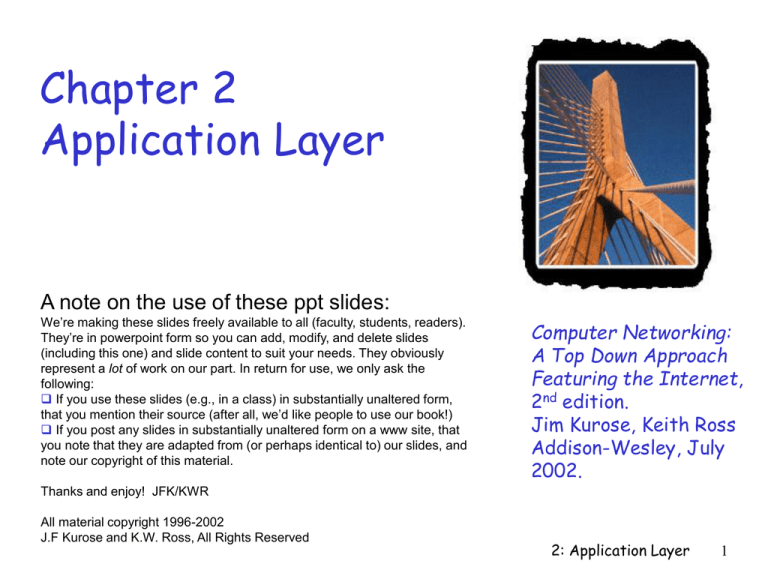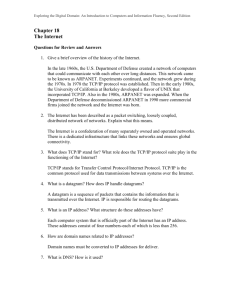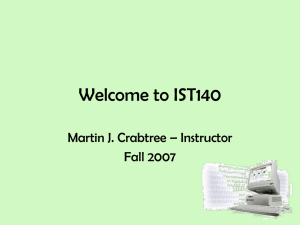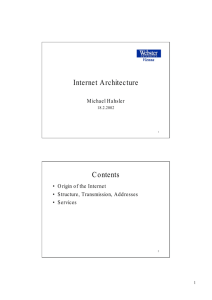
Chapter 2
Application Layer
A note on the use of these ppt slides:
We’re making these slides freely available to all (faculty, students, readers).
They’re in powerpoint form so you can add, modify, and delete slides
(including this one) and slide content to suit your needs. They obviously
represent a lot of work on our part. In return for use, we only ask the
following:
If you use these slides (e.g., in a class) in substantially unaltered form,
that you mention their source (after all, we’d like people to use our book!)
If you post any slides in substantially unaltered form on a www site, that
you note that they are adapted from (or perhaps identical to) our slides, and
note our copyright of this material.
Computer Networking:
A Top Down Approach
Featuring the Internet,
2nd edition.
Jim Kurose, Keith Ross
Addison-Wesley, July
2002.
Thanks and enjoy! JFK/KWR
All material copyright 1996-2002
J.F Kurose and K.W. Ross, All Rights Reserved
2: Application Layer
1
Internet Management- Outline
2.1 Principles of app
layer protocols
clients and servers
app requirements
2.2 Web and HTTP
2.3 FTP
2.9 Content distribution
Network Web caching
Content distribution
networks
P2P file sharing
2.4 Electronic Mail
SMTP, POP3, IMAP
2.5 DNS
2: Application Layer
2
Network applications: some jargon
Process: program running user agent: interfaces
within a host.
with user “above” and
network “below”.
within same host, two
processes communicate implements user
using interprocess
interface &
communication (defined
application-level
by OS).
protocol
Web: browser
processes running in
E-mail: mail reader
different hosts
streaming audio/video:
communicate with an
media player
application-layer
protocol
2: Application Layer
3
Applications and application-layer protocols
Application: communicating,
distributed processes
e.g., e-mail, Web, P2P file
sharing, instant messaging
running in end systems
(hosts)
exchange messages to
implement application
application
transport
network
data link
physical
Application-layer protocols
one “piece” of an app
define messages
exchanged by apps and
actions taken
use communication services
provided by lower layer
protocols (TCP, UDP)
application
transport
network
data link
physical
application
transport
network
data link
physical
2: Application Layer
4
App-layer protocol defines
Types of messages
exchanged, eg, request
& response messages
Syntax of message
types: what fields in
messages & how fields
are delineated
Semantics of the
fields, ie, meaning of
information in fields
Rules for when and
how processes send &
respond to messages
Public-domain protocols:
defined in RFCs
allows for
interoperability
eg, HTTP, SMTP
Proprietary protocols:
eg, KaZaA
2: Application Layer
5
Client-server paradigm
Typical network app has two
pieces: client and server
Client:
application
transport
network
data link
physical
initiates contact with server
(“speaks first”)
typically requests service from
server,
Web: client implemented in
browser; e-mail: in mail reader
Server:
provides requested service to client
request
reply
application
transport
network
data link
physical
e.g., Web server sends requested Web
page, mail server delivers e-mail
2: Application Layer
6
Processes communicating across network
process sends/receives
messages to/from its
socket
socket analogous to door
sending process shoves
message out door
sending process assumes
transport infrastructure
on other side of door which
brings message to socket
at receiving process
host or
server
host or
server
process
controlled by
app developer
process
socket
socket
TCP with
buffers,
variables
Internet
TCP with
buffers,
variables
controlled
by OS
API: (1) choice of transport protocol; (2) ability to fix
a few parameters
2: Application Layer
7
Addressing processes:
For a process to
receive messages, it
must have an identifier
Every host has a unique
32-bit IP address
Q: does the IP address
of the host on which
the process runs
suffice for identifying
the process?
Answer: No, many
processes can be
running on same host
Identifier includes
both the IP address
and port numbers
associated with the
process on the host.
Example port numbers:
HTTP server: 80
Mail server: 25
2: Application Layer
8
What transport service does an app need?
Data loss
some apps (e.g., audio) can
tolerate some loss
other apps (e.g., file
transfer, telnet) require
100% reliable data
transfer
Timing
some apps (e.g.,
Internet telephony,
interactive games)
require low delay to be
“effective”
Bandwidth
some apps (e.g.,
multimedia) require
minimum amount of
bandwidth to be
“effective”
other apps (“elastic
apps”) make use of
whatever bandwidth
they get
2: Application Layer
9
Transport service requirements of common apps
Data loss
Bandwidth
Time Sensitive
file transfer
e-mail
Web documents
real-time audio/video
no loss
no loss
no loss
loss-tolerant
no
no
no
yes, 100’s msec
stored audio/video
interactive games
instant messaging
loss-tolerant
loss-tolerant
no loss
elastic
elastic
elastic
audio: 5kbps-1Mbps
video:10kbps-5Mbps
same as above
few kbps up
elastic
Application
yes, few secs
yes, 100’s msec
yes and no
2: Application Layer
10
Internet transport protocols services
TCP service:
connection-oriented: setup
required between client and
server processes
reliable transport between
sending and receiving process
flow control: sender won’t
overwhelm receiver
congestion control: throttle
sender when network
overloaded
does not providing: timing,
minimum bandwidth
guarantees
UDP service:
unreliable data transfer
between sending and
receiving process
does not provide:
connection setup,
reliability, flow control,
congestion control, timing,
or bandwidth guarantee
Q: why bother? Why is
there a UDP?
2: Application Layer
11
Internet apps: application, transport protocols
Application
e-mail
remote terminal access
Web
file transfer
streaming multimedia
Internet telephony
Application
layer protocol
Underlying
transport protocol
SMTP [RFC 2821]
Telnet [RFC 854]
HTTP [RFC 2616]
FTP [RFC 959]
proprietary
(e.g. RealNetworks)
proprietary
(e.g., Dialpad)
TCP
TCP
TCP
TCP
TCP or UDP
typically UDP
2: Application Layer
12
Chapter 2 outline
2.1 Principles of app
layer protocols
clients and servers
app requirements
2.2 Web and HTTP
2.3 FTP
2.9 Content distribution
Network Web caching
Content distribution
networks
P2P file sharing
2.4 Electronic Mail
SMTP, POP3, IMAP
2.5 DNS
2: Application Layer
13
Web and HTTP
First some jargon
Web page consists of objects
Object can be HTML file, JPEG image, Java
applet, audio file,…
Web page consists of base HTML-file which
includes several referenced objects
Each object is addressable by a URL
Example URL:
www.someschool.edu/someDept/pic.gif
host name
path name
2: Application Layer
14
HTTP overview
HTTP: hypertext
transfer protocol
Web’s application layer
protocol
client/server model
client: browser that
requests, receives,
“displays” Web objects
server: Web server
sends objects in
response to requests
HTTP 1.0: RFC 1945
HTTP 1.1: RFC 2068
PC running
Explorer
Server
running
Apache Web
server
Mac running
Navigator
2: Application Layer
15
HTTP overview (continued)
Uses TCP:
client initiates TCP
connection (creates socket)
to server, port 80
server accepts TCP
connection from client
HTTP messages (applicationlayer protocol messages)
exchanged between browser
(HTTP client) and Web
server (HTTP server)
TCP connection closed
HTTP is “stateless”
server maintains no
information about
past client requests
aside
Protocols that maintain
“state” are complex!
past history (state) must
be maintained
if server/client crashes,
their views of “state” may
be inconsistent, must be
reconciled
2: Application Layer
16
HTTP connections
Nonpersistent HTTP
At most one object is
sent over a TCP
connection.
HTTP/1.0 uses
nonpersistent HTTP
Persistent HTTP
Multiple objects can
be sent over single
TCP connection
between client and
server.
HTTP/1.1 uses
persistent connections
in default mode
2: Application Layer
17
Nonpersistent HTTP
(contains text,
Suppose user enters URL
references to 10
www.someSchool.edu/someDepartment/home.index
jpeg images)
1a. HTTP client initiates TCP
connection to HTTP server
(process) at
www.someSchool.edu on port 80
2. HTTP client sends HTTP
request message (containing
URL) into TCP connection
socket. Message indicates
that client wants object
someDepartment/home.index
1b. HTTP server at host
www.someSchool.edu waiting
for TCP connection at port 80.
“accepts” connection, notifying
client
3. HTTP server receives request
message, forms response
message containing requested
object, and sends message
into its socket
time
2: Application Layer
18
Nonpersistent HTTP (cont.)
4. HTTP server closes TCP
5. HTTP client receives response
connection.
message containing html file,
displays html. Parsing html
file, finds 10 referenced jpeg
objects
time 6. Steps 1-5 repeated for each
of 10 jpeg objects
2: Application Layer
19
Response time modeling
Definition of RRT: time to
send a small packet to
travel from client to
server and back.
Response time:
one RTT to initiate TCP
connection
one RTT for HTTP
request and first few
bytes of HTTP response
to return
file transmission time
total = 2RTT+transmit time
initiate TCP
connection
RTT
request
file
time to
transmit
file
RTT
file
received
time
time
2: Application Layer
20
Persistent HTTP
Nonpersistent HTTP issues:
requires 2 RTTs per object
OS must work and allocate
host resources for each TCP
connection
but browsers often open
parallel TCP connections to
fetch referenced objects
Persistent HTTP
server leaves connection
open after sending response
subsequent HTTP messages
between same client/server
are sent over connection
Persistent without pipelining:
client issues new request
only when previous
response has been received
one RTT for each
referenced object
Persistent with pipelining:
default in HTTP/1.1
client sends requests as
soon as it encounters a
referenced object
as little as one RTT for all
the referenced objects
2: Application Layer
21
HTTP request message
two types of HTTP messages: request, response
HTTP request message:
ASCII (human-readable format)
request line
(GET, POST,
HEAD commands)
GET /somedir/page.html HTTP/1.1
Host: www.someschool.edu
User-agent: Mozilla/4.0
header Connection: close
lines Accept-language:fr
Carriage return,
line feed
indicates end
of message
(extra carriage return, line feed)
2: Application Layer
22
HTTP request message: general format
2: Application Layer
23
Uploading form input
Post method:
Web page often
includes form input
Input is uploaded to
server in entity body
URL method:
Uses GET method
Input is uploaded in
URL field of request
line:
www.somesite.com/animalsearch?monkeys&banana
2: Application Layer
24
Method types
HTTP/1.0
GET
POST
HEAD
asks server to leave
requested object out of
response
HTTP/1.1
GET, POST, HEAD
PUT
uploads file in entity
body to path specified
in URL field
DELETE
deletes file specified in
the URL field
2: Application Layer
25
HTTP response message
status line
(protocol
status code
status phrase)
header
lines
data, e.g.,
requested
HTML file
HTTP/1.1 200 OK
Connection close
Date: Thu, 06 Aug 1998 12:00:15 GMT
Server: Apache/1.3.0 (Unix)
Last-Modified: Mon, 22 Jun 1998 …...
Content-Length: 6821
Content-Type: text/html
data data data data data ...
2: Application Layer
26
HTTP response status codes
In first line in server->client response message.
A few sample codes:
200 OK
request succeeded, requested object later in this message
301 Moved Permanently
requested object moved, new location specified later in
this message (Location:)
400 Bad Request
request message not understood by server
404 Not Found
requested document not found on this server
505 HTTP Version Not Supported
2: Application Layer
27
Trying out HTTP (client side) for yourself
1. Telnet to your favorite Web server:
telnet www.eurecom.fr 80 Opens TCP connection to port 80
(default HTTP server port) at www.eurecom.fr.
Anything typed in sent
to port 80 at www.eurecom.fr
2. Type in a GET HTTP request:
GET /~ross/index.html HTTP/1.0
By typing this in (hit carriage
return twice), you send
this minimal (but complete)
GET request to HTTP server
3. Look at response message sent by HTTP server!
2: Application Layer
28
User-server interaction: authorization
Authorization : control access to
server
client
server content
usual http request msg
authorization credentials:
typically name, password
401: authorization req.
WWW authenticate:
stateless: client must present
authorization in each request
authorization: header line in
usual http request msg
+ Authorization: <cred>
each request
if no authorization: header,
usual http response msg
server refuses access,
sends
WWW authenticate:
header line in response
usual http request msg
+ Authorization: <cred>
usual http response msg
time
2: Application Layer
29
Cookies: keeping “state”
Many major Web sites
use cookies
Four components:
1) cookie header line in
the HTTP response
message
2) cookie header line in
HTTP request message
3) cookie file kept on
user’s host and managed
by user’s browser
4) back-end database at
Web site
Example:
Susan access Internet
always from same PC
She visits a specific ecommerce site for first
time
When initial HTTP
requests arrives at site,
site creates a unique ID
and creates an entry in
backend database for
ID
2: Application Layer
30
Cookies: keeping “state” (cont.)
client
Cookie file
server
usual http request msg
usual http response +
ebay: 8734
Cookie file
amazon: 1678
ebay: 8734
Set-cookie: 1678
usual http request msg
cookie: 1678
usual http response msg
one week later:
Cookie file
amazon: 1678
ebay: 8734
usual http request msg
cookie: 1678
usual http response msg
server
creates ID
1678 for user
cookiespecific
action
cookiespectific
action
2: Application Layer
31
Cookies (continued)
What cookies can bring:
authorization
shopping carts
recommendations
user session state
(Web e-mail)
aside
Cookies and privacy:
cookies permit sites to
learn a lot about you
you may supply name
and e-mail to sites
search engines use
redirection & cookies
to learn yet more
advertising companies
obtain info across
sites
2: Application Layer
32
Conditional GET: client-side caching
Goal: don’t send object if
client has up-to-date cached
version
client: specify date of
cached copy in HTTP request
If-modified-since:
<date>
server: response contains no
object if cached copy is upto-date:
HTTP/1.0 304 Not
Modified
server
client
HTTP request msg
If-modified-since:
<date>
HTTP response
object
not
modified
HTTP/1.0
304 Not Modified
HTTP request msg
If-modified-since:
<date>
HTTP response
object
modified
HTTP/1.0 200 OK
<data>
2: Application Layer
33
Chapter 2 outline
2.1 Principles of app
layer protocols
clients and servers
app requirements
2.2 Web and HTTP
2.3 FTP
2.9 Content distribution
Network Web caching
Content distribution
networks
P2P file sharing
2.4 Electronic Mail
SMTP, POP3, IMAP
2.5 DNS
2: Application Layer
34
FTP: the file transfer protocol
user
at host
FTP
FTP
user
client
interface
file transfer
local file
system
FTP
server
remote file
system
transfer file to/from remote host
client/server model
client: side that initiates transfer (either to/from
remote)
server: remote host
ftp: RFC 959
ftp server: port 21
2: Application Layer
35
FTP: separate control, data connections
TCP control connection
port 21
FTP client contacts FTP
server at port 21, specifying
TCP as transport protocol
Client obtains authorization
over control connection
Client browses remote
directory by sending
commands over control
connection.
When server receives a
command for a file transfer,
the server opens a TCP data
connection to client
After transferring one file,
server closes connection.
FTP
client
TCP data connection
port 20
FTP
server
Server opens a second TCP
data connection to transfer
another file.
Control connection: “out of
band”
FTP server maintains “state”:
current directory, earlier
authentication
2: Application Layer
36
FTP commands, responses
Sample commands:
Sample return codes
sent as ASCII text over
status code and phrase (as
control channel
USER username
PASS password
LIST return list of file in
current directory
RETR filename retrieves
STOR filename stores
(gets) file
(puts) file onto remote
host
in HTTP)
331 Username OK,
password required
125 data connection
already open;
transfer starting
425 Can’t open data
connection
452 Error writing
file
2: Application Layer
37
Review
Q) List 3 Internet apps and app-layer protocols they use
Q) For a communication session between 2 hosts, which host is
client/server?
Q) List various networks apps you use on daily basis
Q) What is meant by a handshaking protocol?
Q) Why do HTTP, FTP run on top pf TCP rather than UDP?
Q) An e-commerce site wants to keep track of its customers
purchases. Explain how to do this with HTTP authentication and how
to do it with cookies.
Q) What is difference between persistent HTTP with pipelining and
persistent HTPP without pipelining?
Q) Why is it said that FTP sends control information “out of band”?
2: Application Layer
38
Q) List 3 Internet apps and app-layer protocols they use
A) The Web: HTTP; file transfer: FTP; remote login: Telnet; -----------------------------------------------Q) For a communication session between 2 hosts, which host is
client/server?
A) The host that initiates the communication session is the client.
-------------------------------------------------------------
2: Application Layer
39
Q) List various networks apps you use on daily basis
A) You probably use a browser and a mail reader on a daily basis. You
may also use an FTP user agent, a Telnet user agent, an audio/video
player user agent (such as a Real Networks player), an instant
messaging agent, a P2P file-sharing agent, etc.
-------------------------------------------Q) What is meant by a handshaking protocol?
A) A protocol uses handshaking if the two communicating entities
first exchange control packets before sending data to each other.
SMTP uses handshaking at the application layer whereas HTTP does
not.
------------------------------
2: Application Layer
40
Q) Why do HTTP, FTP run on top pf TCP rather than UDP?
A) The applications that use those protocols require that all
application data is received in the correct order and without gaps.
TCP provides this service whereas UDP does not.
-------------------------------------------------------------Q) An e-commerce site wants to keep track of its customers
purchases. Explain how to do this with HTTP authentication and how
to do it with cookies.
A) In both cases, the site must keep a database record for the user.
With HTTP authentication, the user first registers with the site.
During each subsequent visit, the user provides a username and
password, which allows the site to identify the user and update the
user’s record. With cookies, the user does not explicitly provide a
username and password each time it visits the site. However,
browser identifies the user by sending the user’s cookie number each
time the user accesses the site.
----------------------------------------------------------------2: Application Layer
41
Q) What is difference between persistent HTTP with pipelining and
persistent HTPP without pipelining?
A) In persistent HTTP without pipelining, the browser first waits to
receive a HTTP response from the server before issuing a new HTTP
request. In persistent HTTP with pipelining, the browser issues
requests as soon as it has a need to do so, without waiting for
response messages from the server.
------------------------------------------------------------Q) Why is it said that FTP sends control information “out of band”?
A) FTP uses two parallel TCP connections, one connection for sending
control information (such as a request to transfer a file) and another
connection for actually transferring the file. Because the control
information is not sent over the same connection that the file is sent
over, FTP sends control information out of band.
2: Application Layer
42









